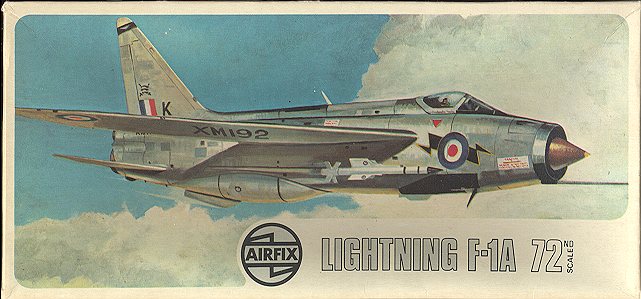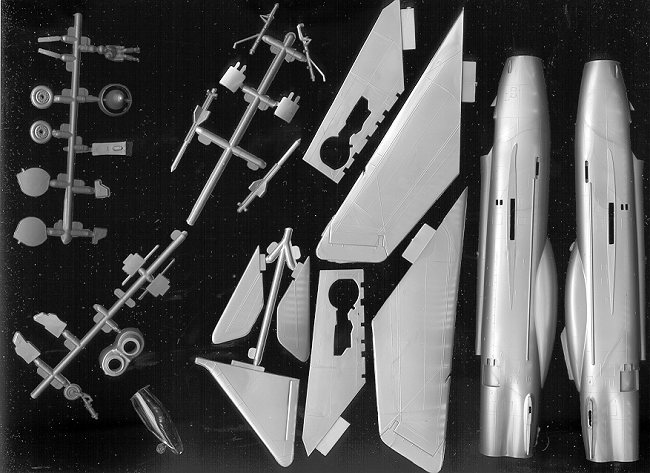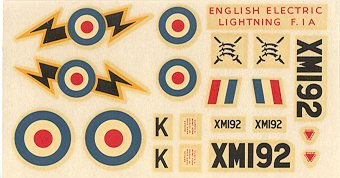
| KIT: | Airfix 1/72 EE. Lighting F.1A |
| KIT # | 2010 |
| PRICE: | $1.49 (30 years ago) |
| DECALS: | One aircraft |
| REVIEW & | |
| NOTES: | Mold permanently altered to do Lightning F.3 |

| HISTORY |
The English Electric (later British Aerospace) Lightning was thefirst and last supersonic single place interceptor built by the British. Many ofus poor Yanks have never had the opportunity to hear the roar of its twin Avonturbojets as it disappeared off into the distance. In England, there are a fewstill around and some of them are still used to perform high-speed runs to thedelight of the crowds. Unfortunately, they are unable to get certification tofly them in the UK. This is because of the lack of a full manual backup controlsystem and the ease at which the flight controls can be accidentally switchedduring maintenance. Never mind that many of the airliners now daily carryingthousands of people are also without a manual backup system as they flit aroundusing fly-by-wire!
Getting back on track, the Lightning was in service for over 25years and went through a number of major variants. The first production versionwas the F.1A with the F.6 being the last one. There were never a large number ofthese aircraft with many variants being a combination of new aircraft andrebuilds of older airframes. The planes went through the full spectrum ofcamouflage schemes from shiny natural metal with vibrant unit coloration to thedull low visibility greys.
The Lighting is one of those aircraft that just lookspurposeful. It is unique in having its twin engines one atop the other.Naturally the British couldn't do it the easy way! It must have been amaintenance nightmare, but it was loved by those who flew it and those whodidn't have to work on it!! The F.1 was armed with two 30mm Aden cannon andtwo Firestreak IR missiles. Top speed was around Mach 2.3, but I'll betthat like the Phantom, it ran out of fuel before it ran out of speed!
| THE KIT |

Unusual for an Airfix kit of this age, there aren't any rivets!!! All of thepanel lines are raised with control surfaces being well engraved. There was darnlittle flash on my kit, though there were a number of ejector pin marks. Thesecritters are on just about every part in the kit. A few sink marks are seen nearalignment pins.
There is basically no detail in the wheel wells or cockpit. You can positionthe speed brakes open. There is no detail in the speed brake well. FewLightnings were seen with these items open. There is little depth to the intakeand exhaust and no intake trunking or exhaust pipes. The transparency is thick,has some deformities and has NO framing on it at all. The main landing gear legsare thin spindly; the nose gear has the wheel molded in with it. The gear doorsare VERY thick.
 Instructions are eight easysteps with one for decals. Any items that need painting prior to constructionare called out. The decals, yellowed with age, are for an aircraft of 111Sq.
Instructions are eight easysteps with one for decals. Any items that need painting prior to constructionare called out. The decals, yellowed with age, are for an aircraft of 111Sq.
Now I know that this doesn't sound too encouraging, but you need to know afew things. First, this is a very old kit and gives a good shape, but that isabout it. Secondly, there are a lot of aftermarket parts for the1/72 Lightning that can be used to spruce up the kit quite a bit. There are alsooodles of aftermarket decals for the early Lightning. Modeldecal alone probablyhas done every variant in every squadron in 1/72. Finally, the F.1A mold hasbeen permanently altered to do an F.3 so this F.1A kit will never bereissued!
As you can see from the enclosed images, I have built a bunch of these kits.It is a simple build and though it doesn't meet today's standards, is one thateven kids will enjoy slapping together.
Review copy courtesy of me and my wallet!
If you would like your product reviewed fairly and fairly quickly by a site that has over 1,000 visits a day, please